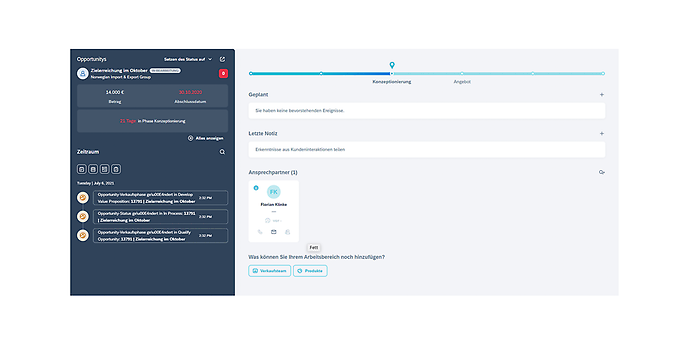13. August 2021 By Florian Klinke
Improved sales management with the SAP Sales Cloud
How to keep an overview in sales management
Whether it’s an on-site customer visit, sending an updated offer or taking part in another phone call, sales staff have a plethora of opportunities to drive potential business and close deals quickly. To be able to make the right decision at the right moment, they have to know their customers inside out and be able to read them in an instant. This preparation takes up a lot of time that could be very well invested elsewhere. On the other hand, it goes without saying that the aim of any sales employee is to guarantee a high conversion rate of potential buyers into customers.
SAP’s Software-as-a-Service (SaaS) solution, SAP Sales Cloud, is a cloud-based customer relationship management system designed to improve the relationship between a company and its customers.
The SAP Sales Cloud can take work off your hands
The Sales Cloud offers various options that are designed to contribute to improved and simplified sales management. One option is lead and opportunity scoring. The different elements are given a score from 0 to 100 points using machine learning. This allows sales staff to view promising sales opportunities at a glance and focus their attention on them. The Sales Assistant is another feature. At the moment, the Sales Assistant reads the current phase of the opportunity and recommends different activities based on the phase. The activities can be individually configured based on a company’s optimal workflow.
Here’s an example from a project: another requirement arose during a cooperation with a business customer that the Sales Cloud couldn’t cover in the way the customer wanted. This requirement is to deploy an enhanced Sales Assistant in SAP Sales Cloud. However, the current form involves only the static forecasting of generic activities. This means that only the phase in which the opportunity is in is considered here. The customer wants a consultant who analyses additional information and generates dynamic forecasts. The point of contact, the manager or even allocating the task to a sales office should be considered here.
Data has a better idea
Based on the requirements to implement a more comprehensive Sales Assistant, all of the stakeholders agreed that the opportunities data would be processed and analysed through machine learning. This follows the principle of ‘data has a better idea’. The aim was to give the sales staff a way to grasp the ideas of the data and to be able to make a decision using their own experience and assessments. Factoring in the sales staff’s own personal assessments had a special significance in the project as it meant that their experience could be linked to the recommendation of the application. The aim was to turn the potential buyer into a long-term customer.
As a first step on the way to realising the application, the expected features were discussed. This allowed the stakeholders to clarify which attributes should be factored into the calculation, but also which communication channel was necessary to meet the expectations. A first draft was also drawn up following this preparation stage.
Once the final requirements analysis was complete, the database for the machine learning was identified. The data relevant for the project was the sales data that concerns the sales opportunities. All of the required data was downloaded, anonymised and prepared for further processing. In this step, the attributes that were deemed as unimportant in the scope of requirements were removed from the data. Information – customers, points of contact or even duration of interest – was kept. Other attributes – for example, who created the attribute or when it was last changed – were removed from the data set. Finally, the information about the sales opportunities was linked to previous activities that were carried in the same context.
Various machine learning methods were tested with the anonymised and cleaned data set. The aim was to find the algorithm that generated the best ideas. These algorithms were then evaluated using various common metrics. The result was that an artificial neural network generated the best ideas for this specific use case.
Two other objectives were pursued during the implementation. The application was to be adapted to the Sales Cloud both visually and in terms of functionality. The visual approach was provided by the SAPUI5 front-end framework. You can see the result in the two images below.
The functional expectations were also successfully met. A two-way connection to the Sales Cloud was established, which meant that information could be loaded from the Sales Cloud to the application and also transferred from the application to the Sales Cloud.
SAP follows the trend
While we were working on our application, something along the same lines was being developed internally at SAP. SAP is currently working on a new feature in the Sales Cloud. Guided Selling is the name of the new feature, which is designed to support sales processes.
Guided Selling provides the sales process in the Sales Cloud with further help. The new view in the Sales Cloud focuses on providing the user with all of the information they need in one place. This allows sales staff, assisted by machine learning, to further drive sales opportunities.
In addition to the new features, Guided Selling is one of the first features to run on the new Sales Cloud user interface. In the future, the new interface technology will replace all of the existing Fiori views and create a new experience for the user. The new feature gives potential and existing customers a positive first impression of the new front-end view. The images below provide an initial glimpse into how it looks.

Guided Selling in the Sales Cloud
Conclusion
I started this blog by saying that the current sales situation presents the sales team with new challenges in terms of time. This means that every member of the sales team has to take a lot of time to make the best possible decision. And SAP Sales Cloud can provide them with assistance in these tasks thanks its functional components, enabling them to build profitable relationships with the business customer. However, the Sales Cloud does not always cover all of the requirements that a business customer may have. This is also true in this specific case, where the customer wants an analysis of the sales opportunities, which serve as the possible recommendations for action.
An application was then developed that can recommend actions for sales opportunities based on this requirement. The finished application was seamlessly introduced into the Sales Cloud, both visually and in terms of functionality, and is now used as part of the Sales Cloud.
This example illustrated that the scope of SAP Sales Cloud’s features, which is already plentiful, can be further adapted to the needs of companies by implementing in-house developments. In this way, the Sales Cloud contributes significantly to improving the sales experience.
SAP is currently working on its own development based on this application. Guided Selling is one of the latest features designed to support sales management. It is a first exclusive look at the new user interface and the new feature. Guided Selling can already be enabled in the beta version.
You can find more on SAP on our homepage. Would you like to read more exciting blog posts from the world of adesso? Then check out our latest blog posts.

